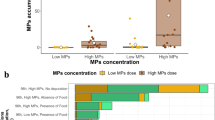Abstract
An important issue in assessing microplastics is whether this newly emerging type of pollution affects freshwater invertebrates. This study was designed to examine the interactions between the amphipod Gammarus fossarum and two types of microplastics. To determine the ingestion and egestion of polyamide (PA) fibres (500 × 20 μm), amphipods were exposed to four concentrations (100, 540, 2680, 13,380 PA fibres cm−2 base area of glass beakers) and four exposure times (0.5, 2, 8, 32 h) as well as four post-exposure times (1, 2, 4, 16 h). We demonstrate a positive correlation between concentration and ingestion of PA fibres. Fibres were found in the gut after 0.5 h of exposure. Egestion was rapid and the digestive tract was empty 16 h after exposure ended. To investigate whether polystyrene (PS) beads (1.6 μm) can be taken up in the epithelial cells of the gut and the midgut glands, four concentrations (500, 2500, 12,500, 60,000 PS beads mL−1) were tested. Cryosections exhibited fluorescent PS beads only within the gut lumen. In a 28-day feeding experiment with both, fibres and beads, we studied the amphipod’s feeding rate, assimilation efficiency and wet weight change. The exposure to PA fibres (2680 PA fibres cm−2 base area of glass beakers) significantly reduced the assimilation efficiency of the animals. While both tested polymer types are ingested and egested, PA fibres can impair the health and ecological functions of freshwater amphipods under continuous exposure.



Similar content being viewed by others
References
Agrawal VP (1965) Feeding appendages and the digestive system of Gammarus pulex. Acta Zool 46:67–81. doi:10.1111/j.1463-6395.1965.tb00727.x
Andrady AL (2011) Microplastics in the marine environment. Mar Pollut Bull 62:1596–1605. doi:10.1016/j.marpolbul.2011.05.030
Au SY, Bruce TF, Bridges WC, Klaine SJ (2015) Responses of Hyalella azteca to acute and chronic microplastic exposures. Environ Toxicol Chem 9999:1–9. doi: 10.1002/etc.3093
Bärlocher F, Kendrick B (1975) Assimilation efficiency of Gammarus pseudolimnaeus (Amphipoda) feeding on fungal mycelium or autumn-shed leaves. Oikos 26:55–59. doi:10.2307/3543277
Bender R, Grouven U, Ziegler A (2007) Varianzanalyse für Messwertwiederholungen. Dtsch Medizinische Wochenschrift 132:61–64. doi:10.1055/s-2007-959045
Besseling E, Wegner A, Foekema EM, et al. (2013) Effects of microplastic on fitness and PCB bioaccumulation by the lugworm Arenicola marina (L.). Environ Sci Technol 47:593–600. doi:10.1021/es302763x
Blinn DW, Johnson DB (1982) Filter-feeding of Hyalella montezuma, an unusual behavior for a freshwater amphipod. Freshw Invertebr Biol 1:48–52. doi:10.2307/3259454
Browne MA, Dissanayake A, Galloway TS, et al. (2008) Ingested microscopic plastic translocates to the circulatory system of the mussel, Mytilus edulis (L). Environ Sci Technol 42:5026–5031. doi:10.1021/es800249a
Browne MA, Underwood AJ, Chapman MG, et al (2015) Linking effects of anthropogenic debris to ecological impacts. Proc Biol Sci 282:20142929. doi: 10.1098/rspb.2014.2929
Bundschuh M, Zubrod JP, Schulz R (2011) The functional and physiological status of Gammarus fossarum (Crustacea; Amphipoda) exposed to secondary treated wastewater. Environ Pollut 159:244–249. doi:10.1016/j.envpol.2010.08.030
Bundschuh M, Zubrod JP, Klemm P, et al. (2013) Effects of peak exposure scenarios on Gammarus fossarum using field relevant pesticide mixtures. Ecotoxicol Environ Saf 95:137–143. doi:10.1016/j.ecoenv.2013.05.025
Castañeda R, Avlijas S, Simard M, Ricciardi A (2014) Microplastic pollution in St. Lawrence River sediments. Can J Fish Aquat Sci 71:1767–1771. doi:10.1139/cjfas-2014-0281
Chapman JW (2007) Amphipoda. In: Carlton JT (ed) The light and Smith manual: intertidal invertebrates from Central California to Oregon, 4th edn. University of California Press, Berkeley and Los Angeles, pp. 545–618
Chua EM, Shimeta J, Nugegoda D, et al. (2014) Assimilation of polybrominated diphenyl ethers from microplastics by the marine amphipod, Allorchestes compressa. Environ Sci Technol 48:8127–8134. doi:10.1021/es405717z
Cole M, Lindeque P, Fileman E, et al. (2013) Microplastic ingestion by zooplankton. Environ Sci Technol 47:6646–6655. doi:10.1021/es400663f
Dris R, Imhof H, Sanchez W, et al. (2015) Beyond the ocean: contamination of freshwater ecosystems with (micro- ) plastic particles. Environ Chem 12:539–550. doi:10.1071/EN14172
Eerkes-Medrano D, Thompson RC, Aldridge DC (2015) Microplastics in freshwater systems: a review of the emerging threats, identification of knowledge gaps and prioritisation of research needs. Water Res 75:63–82. doi:10.1016/j.watres.2015.02.012
Eriksen M, Lebreton LCM, Carson HS, et al. (2014) Plastic pollution in the world’s oceans: more than 5 trillion plastic pieces weighing over 250,000 tons afloat at sea. PLoS One 9:e111913. doi:10.1371/journal.pone.0111913
Farrell P, Nelson K (2013) Trophic level transfer of microplastic: Mytilus edulis (L.) to Carcinus maenas (L.). Environ Pollut 177:1–3. doi:10.1016/j.envpol.2013.01.046
Fielding NJ, MacNeil C, Dick JTA, et al. (2003) Effects of the acanthocephalan parasite Echinorhynchus truttae on the feeding ecology of Gammarus pulex (Crustacea: Amphipoda). J Zool 261:321–325. doi:10.1017/S0952836903004230
Gergs R, Rothhaupt K-O (2008) Feeding rates, assimilation efficiencies and growth of two amphipod species on biodeposited material from zebra mussels. Freshw Biol 53:2494–2503. doi:10.1111/j.1365-2427.2008.02077.x
GESAMP (IMO/FAO/UNESCO-IOC/UNIDO/WMO/IAEA/UN/UNEP/UNDP Joint Group of Experts on the Scientific Aspects of Marine Environmental Protection) (2015) Sources, fate & effects of microplastics in the marine environment—a global assessment. In: Kershaw P (ed) Rep. Stud. GESAMP No. 90. London, pp 1–96
Haley CJ (1997) Comparisons of secondary production, life history, and mouthpart functional morphology between two populations of the amphipod Gammarus minus. Virginia Polytechnic Institute and State University
Hämer J, Gutow L, Köhler A, Saborowski R (2014) Fate of microplastics in the marine isopod Idotea emarginata. Environ Sci Technol 48:13451–13458. doi:10.1021/es501385y
Imhof HK, Ivleva NP, Schmid J, et al. (2013) Contamination of beach sediments of a subalpine lake with microplastic particles. Curr Biol 23:867–868. doi:10.1016/j.cub.2013.09.001
Kanneworff E, Nicolaisen W (1969) The stomach (foregut) of the amphipod Bathyporeia sarsi Watkin. Ophelia 6:211–229. doi:10.1080/00785326.1969.10409650
Kunz PY, Kienle C, Gerhardt A (2010) Gammarus spp. in aquatic ecotoxicology and water quality assessment: toward integrated multilevel tests. Rev Environ Contam Toxicol 205:1–76. doi:10.1007/978-1-4419-5623-1
MacNeil C, Dick JTA, Elwood RW (1997) The trophic ecology of freshwater Gammarus spp. (Crustacea: Amphipoda): problems and perspectives concerning the functional feeding group concept. Biol Rev 72:349–364. doi:10.1111/j.1469-185X.1997.tb00017.x
Maltby L (1994) Stress, shredders and streams: using Gammarus energetics to assess water quality. In: Sutcliffe DW (ed) Water quality and stress indicators in marine and freshwater ecosystems: linking levels of organisation (individuals, populations, communities). Freshwater Biological Association, Cumbria, pp. 98–110
Maltby L, Clayton SA, Yu H, et al. (2000) Using single-species toxicity tests, community-level responses, and toxicity identification evaluations to investigate effluent impacts. Environ Toxicol Chem 19:151–157. doi:10.1002/etc.5620190118
Mani T, Hauk A, Walter U, Burkhardt-Holm P (2015) Microplastics profile along the Rhine River. Sci Rep 5:17988. doi:10.1038/srep17988
Marchant R, Hynes HBN (1981) Field estimates of feeding rate for Gammarus pseudolimnaeus (Crustacea: Amphipoda) in the Credit River, Ontario. Freshw Biol 11:27–36. doi:10.1111/j.1365-2427.1981.tb01240.x
Mattsson K, Ekvall MT, Hansson L, et al. (2015) Altered behavior, physiology, and metabolism in fish exposed to polystyrene nanoparticles. Environ Sci Technol 49:553–561. doi:10.1021/es5053655
McCahon C, Brown A, Pascoe D (1988) The effect of the acanthocephalan Pomphorhynchus laevis (Müller 1776) on the acute toxicity of cadmium to its intermediate host, the amphipod Gammarus pulex (L.). Arch Environ Contam Toxicol 17:239–243. doi:10.1007/BF01056030
Meadows PS, Reid A (1966) The behaviour of Corophium volutator (Crustacea: Amphipoda). J Zool 150:387–399. doi:10.1111/j.1469-7998.1966.tb03013.x
Michel C, Herzog S, de Capitani C, Burkhardt-Holm P, Pietsch C (2014) Natural mineral particles are cytotoxic to rainbow trout gill epithelial cells in vitro. PLoS One 9:e100856. doi:10.1371/journal.pone.0100856
Møller L, Riisgård H (2006) Filter feeding in the burrowing amphipod Corophium volutator. Mar Ecol Prog Ser 322:213–224. doi:10.3354/meps322213
Moore CJ, Moore SL, Leecaster MK, Weisberg SB (2001) A comparison of plastic and plankton in the North Pacific Central Gyre. Mar Pollut Bull 42:1297–1300. doi:10.1016/S0025-326X(01)00114-X
Murray F, Cowie PR (2011) Plastic contamination in the decapod crustacean Nephrops norvegicus (Linnaeus, 1758). Mar Pollut Bull 62:1207–1217. doi:10.1016/j.marpolbul.2011.03.032
Nelson D (2011) Gammarus-microbial interactions: a review. Int J Zool 2011:1–6. doi:10.1155/2011/295026
Oehlmann J, Schulte-Oehlmann U, Kloas W, et al. (2009) A critical analysis of the biological impacts of plasticizers on wildlife. Philos Trans R Soc B Biol Sci 364:2047–2062. doi:10.1098/rstb.2008.0242
PlasticsEurope (2015) Plastics - the facts 2014/2015: an analysis of European plastics production, demand and waste data. http://www.plasticseurope.org/Document/plastics-the-facts-20142015.aspx. Accessed 20 Nov 2015
R Core Team (2014) R: a language and environment for statistical computing. http://www.r-project.org/.
Rasch B, Friese M, Hofmann W, Naumann E (2006) Varianzanalyse mit Messwiederholung. In: Quantitative Methoden Band 2. Springer, Berlin, pp 99–141
Rochman CM, Hoh E, Kurobe T, Teh SJ (2013) Ingested plastic transfers hazardous chemicals to fish and induces hepatic stress. Sci Rep 3:1–7. doi:10.1038/srep03263
Rosenkranz P, Chaudhry Q, Stone V, Fernandes TF (2009) A comparison of nanoparticle and fine particle uptake by Daphnia magna. Environ Toxicol Chem 28:2142–2149. doi:10.1897/08-559.1
Ruxton GD (2006) The unequal variance t-test is an underused alternative to Student’s t-test and the Mann-Whitney U test. Behav Ecol 17:688–690. doi:10.1093/beheco/ark016
Setälä O, Fleming-Lehtinen V, Lehtiniemi M (2014) Ingestion and transfer of microplastics in the planktonic food web. Environ Pollut 185:77–83. doi:10.1016/j.envpol.2013.10.013
Storch V, Burkhardt P (1984) Influence of nutritional stress on the hepatopancreas of Talitrus saltator (Peracarida, Amphipoda). Helgoländer Meeresuntersuchungen 38:65–73
Strus J, Burkhardt P, Storch V (1985) The ultrastructure of the midgut glands in Ligia italica (isopoda) under different nutritional conditions. Helgoländer Meeresuntersuchungen 39:367–374. doi:10.1007/BF01987408
Teuten EL, Rowland SJ, Galloway TS, Thompson RC (2007) Potential for plastics to transport hydrophobic contaminants. Environ Sci Technol 41:7759–7764. doi:10.1021/es071737s
Thompson RC, Olsen Y, Mitchell RP, et al (2004) Lost at sea: where is all the plastic? Science (80- ) 304:838. doi:10.1126/science.1094559
UNEP (United Nations Environment Programme) (2011) UNEP yearbook emerging issues in our global environment 2011. United Nations Environment Programme, Nairobi
Van Cauwenberghe L, Claessens M, Vandegehuchte MB, Janssen CR (2015) Microplastics are taken up by mussels (Mytilus edulis) and lugworms (Arenicola marina) living in natural habitats. Environ Pollut 199:10–17. doi:10.1016/j.envpol.2015.01.008
Von Moos N, Burkhardt-Holm P, Köhler A (2012) Uptake and effects of microplastics on cells and tissue of the blue mussel Mytilus edulis L. after an experimental exposure. Environ Sci Technol 46:11327–11335. doi:10.1021/es302332w
Wagner M, Scherer C, Alvarez-Muñoz D, et al. (2014) Microplastics in freshwater ecosystems: what we know and what we need to know. Environ Sci Eur 26:1–9. doi:10.1186/s12302-014-0012-7
Watts AJR, Lewis C, Goodhead RM, et al. (2014) Uptake and retention of microplastics by the shore crab Carcinus maenas. Environ Sci Technol 48:8823–8830. doi:10.1021/es501090e
Willoughby LG, Earnshaw R (1982) Gut passage times in Gammarus pulex (Crustacea, Amphipoda) and aspects of summer feeding in a stony stream. Hydrobiologia 97:105–117. doi:10.1007/BF00011964
Woodall LC, Sanchez-vidal A, Paterson GLJ, et al. (2014) The deep sea is a major sink for microplastic debris. R Soc Open Sci 1:140317. doi:10.1098/rsos.140317
Wright SL, Rowe D, Thompson RC, Galloway TS (2013) Microplastic ingestion decreases energy reserves in marine worms. Curr Biol 23:1031–1033. doi:10.1016/j.cub.2013.10.068
Acknowledgements
We thank Gerhard Schulz (Nuertingen-Geislingen University, Reutlingen) for providing the two microplastics, Philipp E. Hirsch for support with statistical analysis, as well as him and Thomas Mani for helpful discussions. We would also like to acknowledge the assistance in laboratory procedures by Heidi Schiffer, Nicole Seiler, Sandrine Straub and Attila Ruegg (University of Basel). Michael Stachowitsch and Rachelle Uhlmann provided language assistance.
Author information
Authors and Affiliations
Corresponding author
Ethics declarations
Conflict of interest
The authors declare that they have no conflict of interest.
Research involving human participants and/or animals
Gammarids are not subject to the Swiss Animal Welfare Act.
Additional information
Responsible editor: Philippe Garrigues
Electronic supplementary material
ESM 1
(DOCX 234 kb)
Rights and permissions
About this article
Cite this article
Blarer, P., Burkhardt-Holm, P. Microplastics affect assimilation efficiency in the freshwater amphipod Gammarus fossarum . Environ Sci Pollut Res 23, 23522–23532 (2016). https://doi.org/10.1007/s11356-016-7584-2
Received:
Accepted:
Published:
Issue Date:
DOI: https://doi.org/10.1007/s11356-016-7584-2




